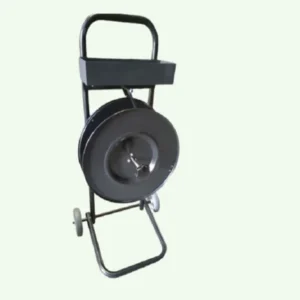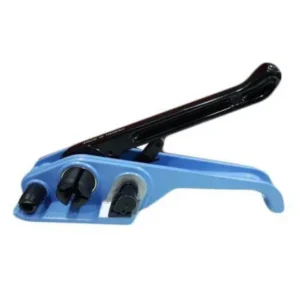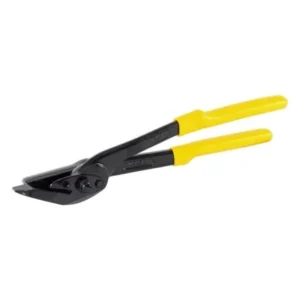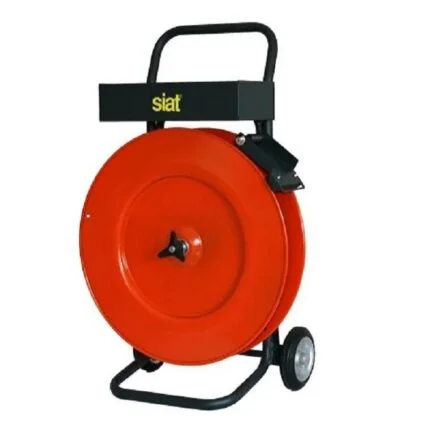manual strapping tool, In the field of packaging and shipping, securing products for transportation is an essential duty. Manual strapping tools are vital in this operation, as they provide a dependable and fast means to bundle and stabilize goods. Whether you’re shipping products across the nation or simply moving items around a warehouse, knowing how to utilize manual strapping tools correctly will help ensure your packages arrive securely and intact. This post will look at the best practices and ideas for increasing the efficiency and efficacy of hand strapping tools.
what is manual strapping tool

manual strapping tool
A manual strapping tool is a portable instrument for applying tension to and securing strapping around containers, pallets, or bundles.
It is widely used in packaging, shipping, and other industrial applications to guarantee that loads are securely fastened for transportation or storage.
These tools do not require an external power source and can be used manually by the user.
read more: steel strapping tensioner
Key Components and Functions:
- Tensioner:
This component applies tension to the strapping material, keeping it tight around the load.
- Sealer:
After the strapping is tightened, a sealer is used to crimp a seal or buckle that secures the strapping in place.
- Cutter:
Some manual strapping tools contain a cutter for removing excess strapping once it has been sealed.
Comparing Different Types of Manual Strapping Tools
Manual strapping equipment is used in many sectors to secure loads with strapping material.
These tools are classified into several categories, each with its own set of features and benefits.
Here’s a comparison between the several sorts of manual strapping tools:
Tensioners.

manual strapping tool
Manual tensioners tighten the strapping around the weight.
- Features:
Designed to provide tension on strapping material.
Typically used with a separate sealing tool.
- Advantages:
Easy to use.
Suitable for both plastic and steel strapping.
💥choose more manual PET & PP Strapping Tools💥👈
Manual cutters
Are used to clip extra strapping once sealed.

manual strapping tool
- Features:
Sharp blade for cutting through plastic or steel strapping.
Frequently integrated into combination tools.
- Advantages:
Ensures a clean cut, minimizing the possibility of sharp edges.
Simple and easy to use.
💥choose more manual steel strapping tools💥👈
How to choose the right manual strapping tool
Choosing the correct manual strapping tools requires an understanding of your individual requirements as well as the features of the many equipment available.
Here are some important aspects to consider when choosing the right manual strapping tools for your application:
Volume of Strapping
For low volume applications, hand tensioners and sealers can be sufficient.
For medium to high volume processes, using streamlined tools can increase efficiency.
Load size and weight.
For small to medium loads, basic hand tools are often sufficient.
For large or heavy loads, more durable or high-tension-specific instruments are required.
Environment
For stationary operations, consider using heavier and more durable tools.
For mobile or on-site use, lightweight and portable tools are preferred.
Operating Efficiency
Choose instruments that are easy to use and require minimum training.
Consider ergonomic tools for reducing operator fatigue, especially during frequent use.
Budget and Cost Considerations
Balance the tool’s initial cost against the long-term benefits and efficiency it brings.
Investing in high-quality tools can reduce maintenance and replacement expenses, leading to long-term savings.
Top Tips for Maximizing Efficiency with Manual Strapping Tools
Several critical procedures must be followed to maximize efficiency while using hand strapping instruments. Here are a few great tips:
Select the appropriate tool for the job.
Type of Strap: Make sure the tool is suitable with the type and size of strap you’re using (plastic, steel, etc.).
Regularly examine and maintain tools to ensure they are in good operating order.
- Proper Training Programmes:
Conduct comprehensive training sessions for all operators to ensure they understand how to use the tools properly and safely.
- Refresher Courses:
Periodic training upgrades keep everyone up to date on best practices and safety protocols.
Ergonomic
Tools can reduce operator fatigue.
- Workstation Setup:
Arrange workstations to reduce repeated strain and allow for simple access to resources.
Material Prep
- Organize supplies:
To save time looking for materials, keep straps, seals, and tools organized and easily accessible.
- Pre-Cut Straps:
To save time when strapping, pre-cut straps to the appropriate length.
Optimize the strapping process.
- Standardize processes:
Create and implement strapping processes that are consistent and efficient.
- Batch Processing:
Whenever possible, combine similar strapping jobs to reduce downtime between them.
Tool Maintenance
- Regular inspections:
Conduct frequent inspections to check for wear and tear, and execute any necessary maintenance to avoid breakdowns.
- Clean Tools:
Keep your tools clean and clear of debris to ensure they run properly.
Best Practices for Using Manual Strapping Tools
To use hand strapping tools effectively, follow best practices that assure the safety, efficiency, and longevity of both the tools and the materials being strapped. Below are some best practices:
Proper Tool Selection
- Tool Type:
Select the appropriate manual strapping tool (tensioner, sealer, or combination tool) for the strapping material and load.
- Ergonomics:
Look for ergonomically built products to reduce operator fatigue and boost efficiency.
Training and skill development.
- Operator Training:
Ensure that all operators are properly trained in the use of manual strapping instruments and understand the specific needs of the materials being strapped.
Provide extensive safety instruction to help prevent injuries throughout the strapping process.
Tool Maintenance and Inspection
- Regular Maintenance:
Lubricate tools on a regular basis and inspect them for wear and tear.
- Inspection :
Regularly inspect tools for damage or wear, and replace any worn-out parts to guarantee proper operation.
Correct Usage Techniques
- Proper Tensioning:
Apply the appropriate amount of tension to the strap to guarantee a secure grasp without injuring either the load or the strap.
- Consistent Sealing:
To prevent strap failure, ensure that seals are placed consistently and firmly.
- Edge Protection:
When working with sharp or fragile loads, use edge guards to keep both the load and the strap safe.
Safety Measures.
- Protective Gear:
Use proper personal protection equipment (PPE), such as gloves and safety glasses.
Follow safe handling methods to avoid injury from sharp edges or high tension straps.
Stay Informed.
- Updates from the Industry:
Stay informed about new products or techniques in the strapping industry that may enhance productivity and security.
- Continuous Improvement:
To improve tool usage and strapping procedures, put continuous improvement techniques into effect.
All in all, Manual strapping tools from Hadanco are essential in the packaging and shipping industries, providing a reliable technique of fastening and stabilizing products. You can assure efficient and safe operations by using the correct tools, adhering to best practices, and putting regular maintenance and training first.
Using these tactics can improve not only the effectiveness of your strapping procedure, but also the overall safety and reliability of your shipments. Manual strapping tools, when used correctly, can considerably streamline packaging processes while also protecting your important cargo. For more details and offers you can contact our team now.

